 W
WAgkistrodon bilineatus is a highly venomous pit viper species found in Mexico and Central America as far south as Honduras.
 W
WAnolis allisoni, also known commonly as Allison's anole or the blue-headed anole, is a species of lizard in the family Dactyloidae. The species is endemic to Cuba, the Bay Islands and Cayos Cochinos off the mainland of Honduras, and Half Moon Caye off the mainland of Belize. There is also a single doubtful record from Cozumel, Mexico. This diurnal species is commonly seen on palm trunks, and it feeds on invertebrates. It is among the relatively few anole species in which females may lay their eggs together, forming a communal nest.
 W
WAnolis biporcatus, also known as the neotropical green anole or giant green anole, is a species of anole. It is found in forests, both disturbed and undisturbed, in Mexico, Central America, Colombia and Venezuela. More southern populations, in southwestern Colombia and western Ecuador, were recognized as a separate species, A. parvauritus, in 2017.
 W
WBothriechis bicolor is a venomous pit viper species found in southern Mexico, Guatemala and Honduras. The specific name refers to the contrasting ventral and dorsal colors. No subspecies are currently recognized.
 W
WBothriechis schlegelii, known commonly as the eyelash viper, is a species of venomous pit viper in the family Viperidae. The species is native to Central and South America. Small and arboreal, this species is characterized by a wide array of color variations, as well as the superciliary scales above the eyes. It is the most common of the green palm-pitvipers, and is often present in zoological exhibits. The specific name schlegelii honors Hermann Schlegel, who was a German ornithologist and herpetologist. For other common names see below. No subspecies are currently recognized as being valid.
 W
WBothriechis thalassinus is a venomous pitviper species native to Guatemala and Honduras.
 W
WBothrops asper is a highly venomous pit viper species, ranging in distribution from southern Mexico to northern South America. It is found in a wide range of lowland habitats, often near human habitations. Because of its proximity to human habitations and its defensive temperament, it is more dangerous to people than many other snakes. This species is the main cause of snakebite incidents within its range. No subspecies are currently recognized.
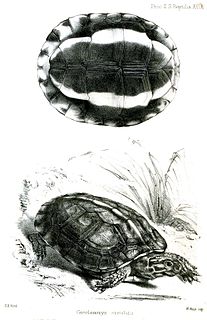 W
WThe brown wood turtle or brown land turtle is a species of turtle in the family Geoemydidae. The species is endemic to Central America and northern South America.
 W
WThe spectacled caiman, also known as the white caiman, common caiman, and speckled caiman, is a crocodilian in the family Alligatoridae. It is brownish-, greenish-, or yellowish-gray colored and has a spectacle-like ridge between its eyes, which is where its common name come from. It grows to a length of 1.4–2.5 metres (4.6–8.2 ft) and a weight of 7–40 kilograms (15–88 lb), with males being both longer and heavier than females. Its diet varies seasonally, commonly consisting of crabs, fish, mammals, and snails. Breeding occurs from May to August and 14–40 eggs are laid in July and August. This crocodilian has a large range and population, native to much of Latin American and introduced to the United States.
 W
WThe Central American snapping turtle, also known commonly as the Mexican snapping turtle and the Yucatan snapping turtle, is a species of turtle in the family Chelydridae. The species is endemic to Central America and Mexico.
 W
WConiophanes piceivittis, known commonly as the black-striped snake or Cope's black-striped snake, is a species of small snake in the subfamily Dipsadinae of the family Colubridae. The species is endemic to Central America and Mexico, and is found in a wide range of habitats.
 W
WThe American crocodile is a species of crocodilian found in the Neotropics. It is the most widespread of the four extant species of crocodiles from the Americas, with populations present from South Florida and the coasts of Mexico to as far south as Peru and Venezuela.
 W
WCtenosaura melanosterna, commonly known as the black-chested spiny-tailed iguana or Honduran spinytailed iguana, is a species of lizard in the family Iguanidae.
 W
WCtenosaura praeocularis, commonly known as the Southern Honduran Spiny-tailed Iguana, is a species of lizard in the family Iguanidae.
 W
WCtenosaura similis, commonly known as the black spiny-tailed iguana, black iguana, or black ctenosaur, is a lizard native to Mexico and Central America that has been introduced to the United States in the state of Florida. It is the largest species in the genus Ctenosaura and has been recorded as the fastest-running species of lizard.
 W
WDendrophidion percarinatum, commonly known as the South American forest racer, is a snake of the colubrid family.
 W
WThe eastern casquehead iguana is a species of lizard in the family Corytophanidae. The species is endemic to Central America and Mexico.
 W
WThe furrowed wood turtle is a species of turtle belonging to the genus Rhinoclemmys of the family Geoemydidae found in the Yucatán Peninsula and adjacent regions of Central America.
 W
WLampropeltis abnorma, commonly known as the Guatemalan milk snake, is a species of milk snake.
 W
WThe green iguana, also known as the American iguana, is a large, arboreal, mostly herbivorous species of lizard of the genus Iguana. Usually, this animal is simply called the iguana. The green iguana ranges over a large geographic area; it is native from southern Brazil and Paraguay as far north as Mexico, and has been introduced from South America to Puerto Rico and is very common throughout the island, where it is colloquially known as gallina de palo and considered an invasive species; in the United States, feral populations also exist in South Florida, Hawaii, the U.S. Virgin Islands and the Rio Grande Valley of Texas. Green iguanas have also successfully colonised the island of Anguilla, arriving on the island in 1995 after rafting across the Caribbean from Guadeloupe.
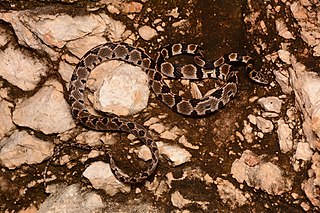 W
WImantodes gemmistratus is a snake species in the colubrid family, found from Mexico, through Central America and Colombia.
 W
WLeiocephalus carinatus, commonly known as the northern curly-tailed lizard, is a species of lizard in the family Leiocephalidae.
 W
WLeptodrymus is a genus of snake in the family Colubridae that contains the sole species Leptodrymus pulcherrimus. It is known as the striped lowland snake or green-headed racer.
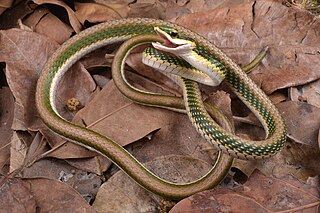 W
WLeptophis mexicanus, commonly known as the Mexican parrot snake, is a species of medium-sized slender snake in the family Colubridae. The species is endemic to the Americas.
 W
WLeptophis modestus, commonly known as the cloud forest parrot snake, is a species of medium-sized slender snake of the family Colubridae. It is endemic to Mesoamerica. There are currently no recognized subspecies.
 W
WThe Madrean alligator lizard is a species of lizard in the family Anguidae. The species is endemic to the southwestern United States and adjacent northwestern Mexico.
 W
WThe Roatán skink is a species of skink found on Roatán in Honduras.
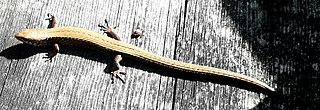 W
WMesaspis moreletii, commonly known as Morelet's alligator lizard, is a species of lizard in the family Anguidae. The species is endemic to Central America.
 W
WThe Meso-American slider is a species of turtle belonging to the family Emydidae. The species is distributed from Mexico to Colombia.
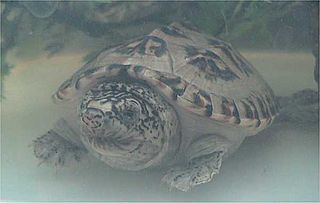 W
WThe Mexican musk turtle, also known commonly as the narrow-bridged musk turtle, is a species of turtle in the family Kinosternidae. The species is endemic to Central America and Mexico.
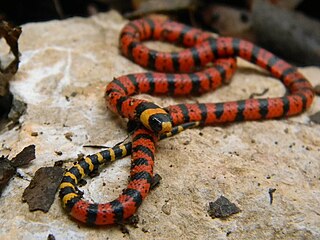 W
WMicrurus diastema, commonly known as the variable coral snake, is a species of venomous snake in the family Elapidae. The species is endemic to southeastern Mexico and northern Central America. There are seven recognized subspecies.
 W
WMicrurus nigrocinctus, commonly known as the Central American coral snake, is a species of a highly venomous snake in the family Elapidae. The species is endemic to Latin America from southern Mexico, Central America, to north Colombia. There are six recognized subspecies, including the nominate subspecies described here.
 W
WThe Middle American burrowing snake is a species of dipsadine colubrid snake, endemic to Mexico and Central America.
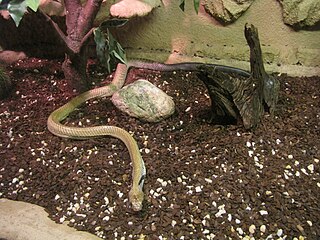 W
WThe Middle American indigo snake, also known commonly as the blacktail cribo, is a species of large, nonvenomous, snake in the family Colubridae. The species is endemic to the southwestern United States, Mexico, Central America, and northern South America. In addition to the nominotypical subspecies, it has four other recognized subspecies, including D. m. erebennus commonly known as the Texas indigo snake.
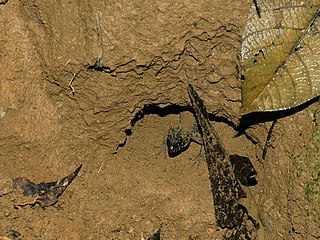 W
WThe yellow-spotted tropical night lizard or yellow-spotted night lizard is a species of night lizard. It is distributed from central Mexico through the Central America south to Panama. It includes four subspecies:Lepidophyma flavimaculatum flavimaculatum Lepidophyma flavimaculatum ophiophthalmum Lepidophyma flavimaculatum tehuanae Lepidophyma flavimaculatum tenebrarum
 W
WNinia sebae, commonly known as the redback coffee snake or the red coffee snake, is a species of small terrestrial snake in the family Colubridae. The species is endemic to Mexico and Central America south to Costa Rica. Although it resembles some venomous coral snakes in color and size, it is not venomous and seldom bites humans.
 W
WOxybelis fulgidus, commonly known as the green vine snake or the flatbread snake, is a species of long, slender, arboreal colubrid snake, which is endemic to Central America and northern South America.
 W
WOxyrhopus petolarius, commonly known as the false coral, is a species of snake in the family Colubridae. The species is endemic to South America. There are three recognized subspecies.
 W
WPhrynonax poecilonotus is a species of nonvenomous snake in the family Colubridae. The species is endemic to the New World.
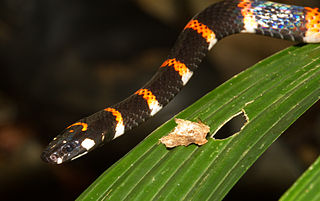 W
WPliocercus euryzonus, commonly known as Cope's false coral snake, is a species of snake in the subfamily Dipsadinae of the family Colubridae. The species is indigenous to southeastern Central America and northwestern South America. There are two recognized subspecies.
 W
WPolychrus gutturosus, also known as Berthold's bush anole or monkey tailed anole, is a species of lizard found in tropical Central and South America. It is sometimes referred to as a "forest iguana". It lives in forests and jungles from Honduras to Ecuador. It can reach up to 70 cm (2.3 ft) in total length, including its very long tail, and males are considerably smaller than females. This insectivorous lizard is a climbing species that can often be seen holding onto branches. It can even hold on with its hind legs, though it moves slowly that way.
 W
WPorthidium nasutum is a venomous pitviper species found in Mexico, Central America and northern South America. No subspecies are currently recognized.
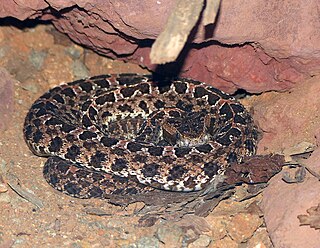 W
WPorthidium ophryomegas is a venomous pitviper species found in Central America. No subspecies are currently recognized.
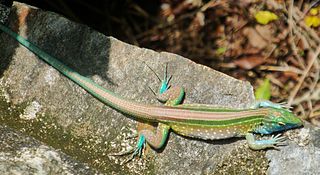 W
WThe rainbow whiptail is a species of lizard found in Central America, the Caribbean, and northern South America. It has also been introduced in Florida and has established populations there. A rainbow whiptail grows up to approximately 12 inches (30.5 cm).
 W
WRhinobothryum bovallii, commonly known as the coral mimic snake or the false tree coral, is a species of snake in the family Colubridae. The species is endemic to Central America and northwestern South America.
 W
WThe Roatán coral snake also known as Coral de la Isle de Roatán or Coral Roatanense in Spanish is a critically endangered species of elapid snake, endemic to the island of Roatán off of the coast of Honduras. There are no recognized subspecies.
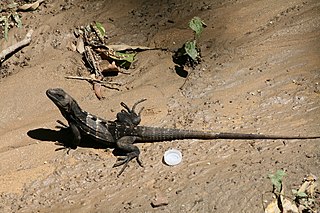 W
WCtenosaura oedirhina, commonly known as the Roatán spiny-tailed iguana or de Queiroz's Spiny-tailed Iguana, is a species of lizard in the family Iguanidae. It is endemic to Honduras and the island of Roatán, to which one of its common names refers.
 W
WScaphiodontophis venustissimus, commonly known as the common neckband snake, is a snake of the colubrid family.
 W
WSibon dimidiatus is a species of snake in the family Colubridae. It is found in Central America.
 W
WSibon longifrenis is a species of snake in the family Colubridae. It is found in Panama, Costa Rica, Honduras and Nicaragua.
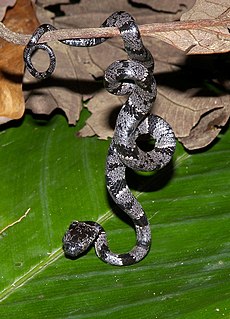 W
WSibon nebulatus, commonly known as the clouded snake, is a species of small, slender arboreal snake which is found in southern Mexico, Central America, northern South America, Isla Margarita, and Trinidad and Tobago.
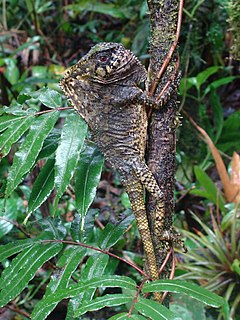 W
WThe smooth helmeted iguana, sometimes also known as helmeted iguana, helmeted basilisk, elegant helmeted lizard, etc., is a species of New World lizard in the family Corytophanidae.
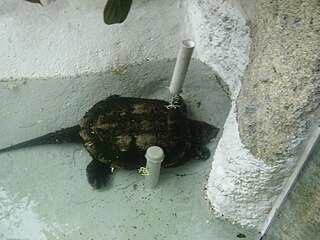 W
WThe South American snapping turtle is a species of turtle in the family Chelydridae. This species, which is endemic to Central and northwestern South America, was previously considered a subspecies of Chelydra serpentina. Its restricted range in South America reflects its recent arrival there as part of the Great American Interchange.
 W
WSphaerodactylus glaucus is a species of gecko known by the common name collared dwarf gecko or least gecko.. It is native to Mexico and parts of Central America, its range extending from Oaxaca and Veracruz in Mexico through Guatemala to Honduras.
 W
WStaurotypus is a genus of aquatic turtles, commonly known as giant musk turtles, Mexican musk turtles, or three-keeled musk turtles, in the family Kinosternidae. The genus contains two recognized species, which are endemic to Mexico and Central America.
 W
WTantilla melanocephala, commonly known as the black-headed snake, is a species of small colubrid snake endemic to Central America and South America.
 W
WThamnophis proximus, commonly known as the western ribbon snake, is a species of garter snake in the subfamily Natricinae of the family Colubridae. The species is endemic to the western United States, Mexico, and Central America. The species has six recognized subspecies.
 W
WThe Central American river turtle, also known locally as the hickatee or tortuga blanca, is the only living species in the family Dermatemydidae. Its closest relatives are only known from fossils with some 19 genera described from a worldwide distribution from the Jurassic and Cretaceous. The species is currently found in the Atlantic drainages of Central America, specifically southern Mexico, Belize and Guatemala. It is a relatively large-bodied species, with historical records of 60 cm (24 in) stright carapace length and weights of 22 kg (49 lb); however, more recent records have found few individuals over 14 kg (31 lb) in Mexico or 11 kg (24 lb) in Guatemala.
 W
WThe white-lipped mud turtle is a species of mud turtle in the family Kinosternidae. The species is endemic to Central America and northwestern South America.
 W
WGonatodes albogularis, which has been called a number of vernacular names in English, is a smallish species of gecko found in warm parts of Central and South America, Cuba, Hispaniola and Jamaica. It is sexually dimorphic: the male is colourful, while the female is a more drab grey. The fingers do not have lamellar pads for climbing smooth surfaces like many other geckos but instead have normal claws like most lizards. At one time the species had a breeding population in southern Florida, especially Key West, but this population appears to have died out by the early 1990s.